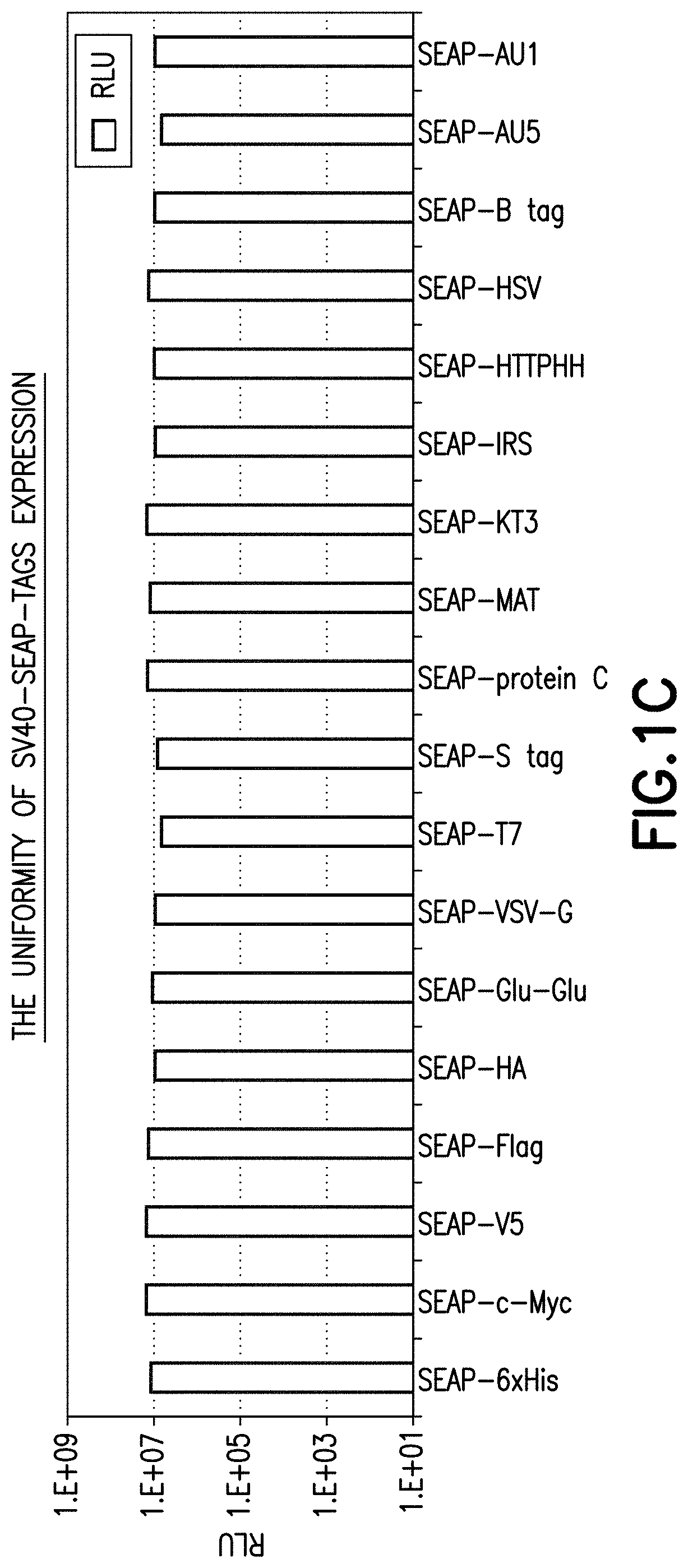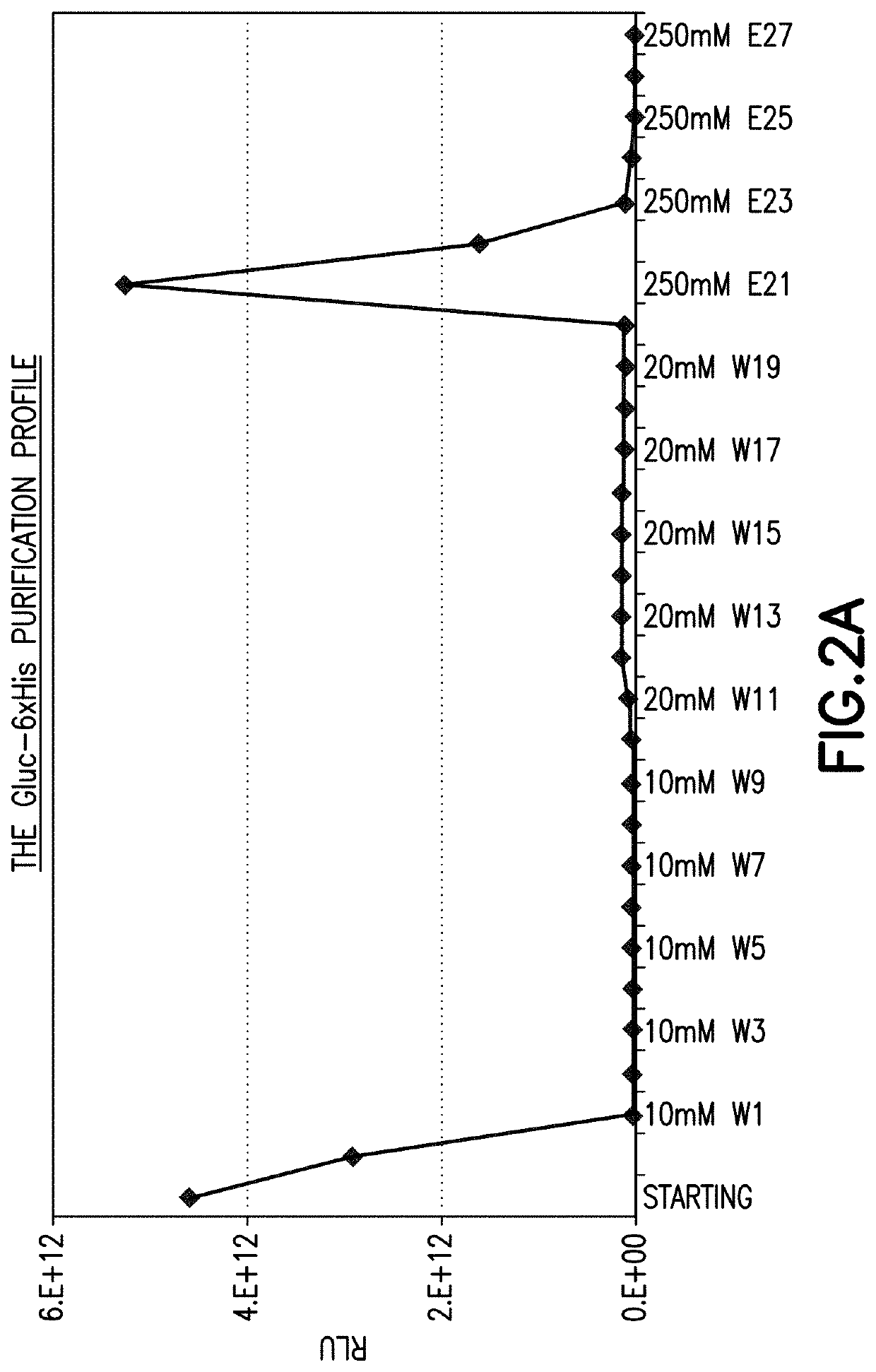Multiplexing transcription factor reporter protein assay process and system
a reporter protein and reporter technology, applied in the field of multi-functional transcription factor reporter protein assay process and system, can solve the problems of insufficient functional status determination of simple tf protein expression, inability to analyze the activity of multiple tfs in the entire gene regulatory network, and inability to analyze the complete functional status of dna binding alon
- Summary
- Abstract
- Description
- Claims
- Application Information
AI Technical Summary
Benefits of technology
Problems solved by technology
Method used
Image
Examples
example 1
Construction of Reporter Plasmid Constructs
[0173]A linker with XbaI and Fse I digestion sites was inserted after the last amino acid codon of Gluc peptide. Different 5-15 amino acid length tags were inserted between XbaI and Fse I, using adaptors. Standard molecular cloning techniques were used.
[0174]Where Gluc was used as the reporter, constructs for all of Gluc-6×His, Gluc-c-Myc, Gluc-V5, Gluc-FLAG™ octapeptide marker tag DYKDDDDK (SEQ ID NO: 2), Gluc-HA, Gluc-Glu-Glu, Gluc-VSV-G, Gluc-T7, Gluc-S tag, Gluc-protein C, Gluc MAT™ heptapeptide marker tag HNHRHKH (SEQ ID NO: 3), Gluc-KT3, Gluc-IRS, Gluc-HTTPHH (SEQ ID NO: 1), Gluc-HSV, Gluc-B tag, Gluc-AU5, and Gluc-AU1 were generated under a CMV promoter and the protein was expressed in 293H and HepG2 cells.
[0175]Where SEAP was used as the reporter, constructs for all of SEAP-6×His, SEAP-c-Myc, SEAP-V5, SEAP-FLAG™ octapeptide marker tag DYKDDDDK (SEQ ID NO: 2), SEAP-HA, SEAP-Glu-Glu, SEAP-VSV-G, SEAP-T7, SEAP-S tag, SEAP-protein C, SE...
example 2
High Throughput Reporter Assay
[0176]Purified Antibodies were diluted in DPBS with 5% glycerol at 5 μg / ml concentration. 50 μk of diluted antibody solutions were dispensed onto wells of a LUMITRAC 600 plate (Greiner Bio-One, Monroe, N.C.), and the plate was tapped gently to distribute the antibody solutions evenly on the bottom of the well. The plate was sealed tightly with a PCR sealing film. The antibody plate was stored at 4° C. for one week for antibodies to bind.
[0177]At the end of incubation, 200 μl of Blocking Reagent (Attagene, Research Triangle Park, N.C.) was added to the wells to block the unbounded surface, either for 1 hour at room temperature for quick use, or at 4° C. overnight. The plate was washed 4 times with DPBS (Invitrogen, Carlsbad, Calif.) by flicking the solution out into a waste container and then blotted dry briefly on layers of paper towel. Target samples were diluted in Binding Reagent (Attagene, Inc., Research Triangle Park, N.C.). After the washing, 100 ...
example 3
[0179]HepG2 and 293H cells were grown in high glucose DMEM medium (Invitrogen, Carlsbad, Calif.) with 10% FBS (Hyclone, Logan, Utah) and 1× antibiotics solution (Invitrogen, Carlsbad, Calif.) at 37° C. and 5% CO2.
[0180]Gluc Factorial and Regular Factorial assays were carried out in the 293H cells (Regular Factorial assays being more fully described in U.S. Patent Application Publication 20100009348 of Sergei Romanov, et al., the disclosure of which is hereby incorporated herein by reference). The results are shown in FIGS. 13A and 13B.
[0181]FIG. 14 is an illustration of an exemplary assay system and process according to one embodiment of the invention. Reporters are introduced individually and employed to make stable clones that are mixed at a desired ratio, or alternatively a premixed library of reporters is utilized. The reporter material then is seeded in plates. Alternatively, a transfected premixed library may be introduced directly into wells. Following 1 hour in...
PUM
| Property | Measurement | Unit |
|---|---|---|
| temperature | aaaaa | aaaaa |
| time | aaaaa | aaaaa |
| physical | aaaaa | aaaaa |
Abstract
Description
Claims
Application Information
 Login to View More
Login to View More - R&D
- Intellectual Property
- Life Sciences
- Materials
- Tech Scout
- Unparalleled Data Quality
- Higher Quality Content
- 60% Fewer Hallucinations
Browse by: Latest US Patents, China's latest patents, Technical Efficacy Thesaurus, Application Domain, Technology Topic, Popular Technical Reports.
© 2025 PatSnap. All rights reserved.Legal|Privacy policy|Modern Slavery Act Transparency Statement|Sitemap|About US| Contact US: help@patsnap.com



